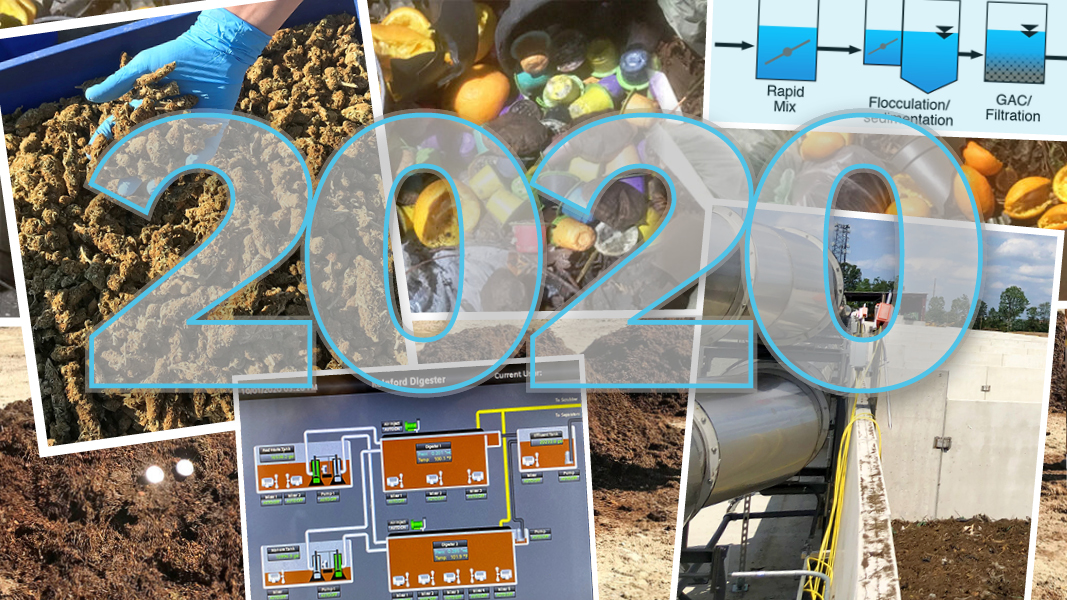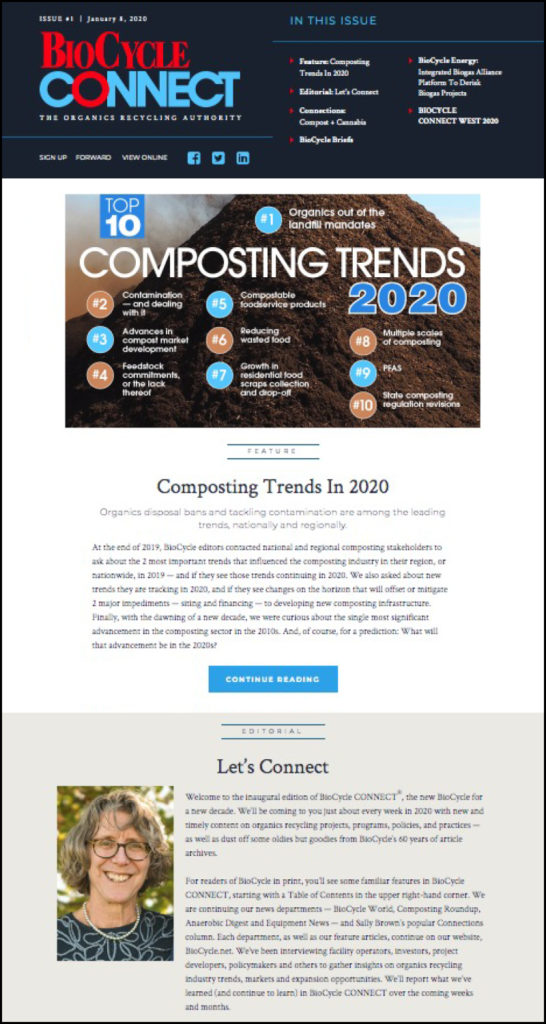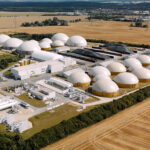Nora Goldstein
The beginning of 2020 was a little bittersweet as we officially marked the end of the print edition of BioCycle after 60 years, and fully threw our hat in the ring of digital publishing. BioCycle CONNECT debuted on January 8 when the first edition was sent to about 15,700 readers. A month later, we passed the 16,000 mark, and have continued to add new readers from across the organics recycling spectrum as the year went on.
Our thanks for being part of the BioCycle digital community — to you, our readers, our content contributors, and to our advertisers who have supported BioCycle CONNECT and BioCycle.net. Our advertisers have been critical to our ability to continue bringing you in-depth editorial coverage on composting, anaerobic digestion, food waste management, renewable power and natural gas, compost utilization, community composting, climate resilience and more in 2020. And as we head into 2021, their support continues, for which we are grateful.
Navigating COVID-19
Everyone in the world has been impacted by the COVID-19 pandemic, either directly by a personal and/or professional loss, or by dramatic changes in the markets serviced by or benefitting from organics recycling. Commercial organics diversion is a case in point, with so many foodservice operations, e.g., universities, convention centers, corporate campuses, restaurants, hotels and resorts either closed or operating as skeletons of their former selves.
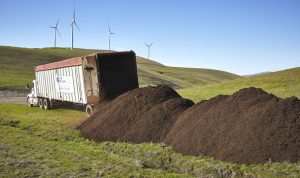
Compost application in Alameda County (CA) as part of a carbon sequestration research project. Photo courtesy of StopWaste.org
At the same time, with more people quarantining at home, 2020 saw a boom in compost purchases by the residential sector. We spoke with many composters who were sold out of inventory a month or two earlier than they would be in a normal year. We have also seen a jump in residential food scraps drop-off — fueled in part by more people cooking at home — being offered by municipalities and by organics collection services. Creating this behavior of source separating food scraps will likely continue post-pandemic, especially with an increasing focus on what communities can do to mitigate greenhouse gas emissions and utilize compost for carbon sequestration.
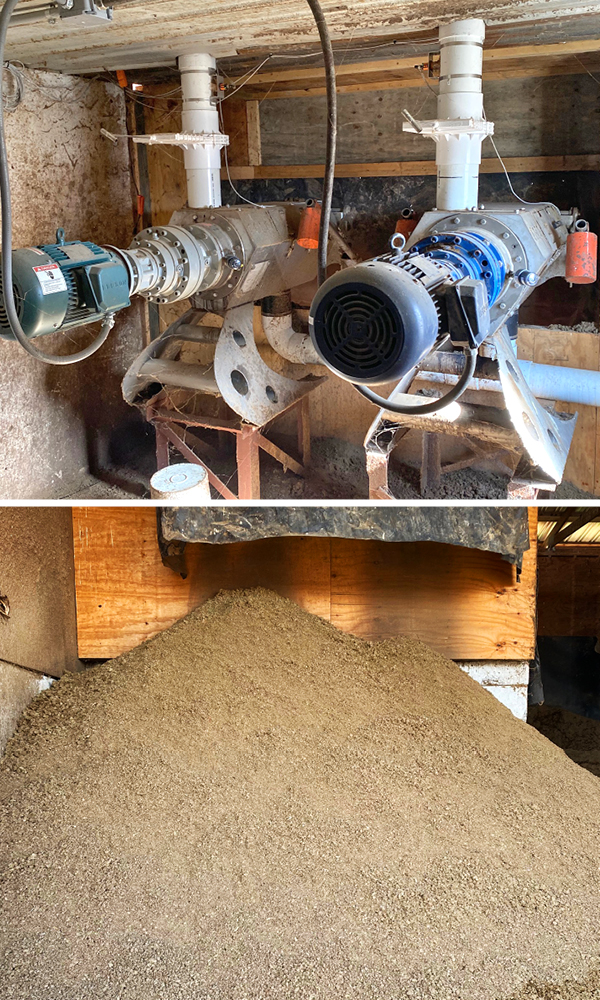
Digested manure solids separation and digestate to be used as dairy cow bedding. Photos courtesy of Reinford Farms
On the biogas side, demand continued to grow for renewable natural gas (RNG), driven in large part by California’s robust low carbon fuels market and a focus on greening heavy-duty vehicle fleets. More natural gas utilities are considering or actively pursuing sources of RNG to offer customers a “non-fossil” alternative. Companies such as U.S. Gain, Brightmark, and Vanguard Renewables are actively developing RNG projects at anaerobic digesters. With a change in Administration at the federal level, there is also hope for activation of the electric vehicle pathway in the Renewable Fuels Standard (“e-RINs”), which would be a boost to digester operators that generate electricity.
Readers’ Clicks
A fascinating element of BioCycle’s transition to a digital platform has been the ability to gauge readers’ interest in the editorial content of BioCycle CONNECT (and on BioCycle.net). Over the course of each month’s editions, we serve up facility features; deep dives into composting and compost use, AD and biogas and digestate use, food recovery and food waste management, community composting, and organics collection and preprocessing; “hot topics” like PFAS and compostable packaging; federal, state and local policies; and academic research. After 48 editions of BioCycle CONNECT in 2020, we can say, based on the data, that our readers are interested in all of these topics, and others, on a consistent basis.
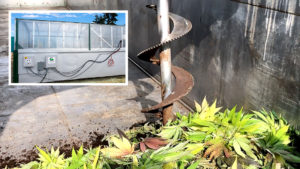
Composting cannabis waste at FlowR™, a grower near Toronto, Ontario. Photo courtesy of Green Mountain Technologies
I took a look at the articles (“posts” in digital vernacular) that received the highest number of clicks in 2020. Leading the pack was our Top 10 Composting Trends in the January 8 inaugural edition, followed closely by articles on PFAS and composting, cannabis waste composting, odor management, edible food recovery, California’s sweeping SB 1383 organics management regulations, more PFAS, COVID-19 and organics recycling, a new composting facility feature, EPA’s new wasted food measurement methodology, compost—the cheapest irrigation system, fate of compostable products in industrial composting, incorporating depackaging at a composting facility, AgSTAR’s digester project management handbook, compost and humic substances, financing composting infrastructure, state of community composting, the art and science of codigestion on a dairy farm, and why regenerative agriculture needs recycled organics.
Part of BioCycle’s transition from print to digital was the launch of the new BioCycle.net website in June 2020. All editorial content in BioCycle, dating back to late 2013, is available to our readers and BioCycle.net visitors, free of charge. Combined with a new, robust search engine, it has been fun to see BioCycle.net articles be at or close to the top in Google search results.
In 2020, The JG Press, Inc., dba BioCycle, also had to navigate the impacts of COVID-19. BioCycle Conferences had to be canceled in 2020, including ones scheduled in 2021. And to better reflect our current operations, a new company, BioCycle Connect, LLC is being formed to replace The JG Press, Inc. What has stayed the same throughout COVID-19 — and reflected over the many decades — is our passion for all things organics recycling, our commitment to provide high-quality, transparent editorial content, our thirst for collecting data to track trends, and best of all, being able to tell your stories.
All the best wishes for a happy, healthy and hopeful 2021.


